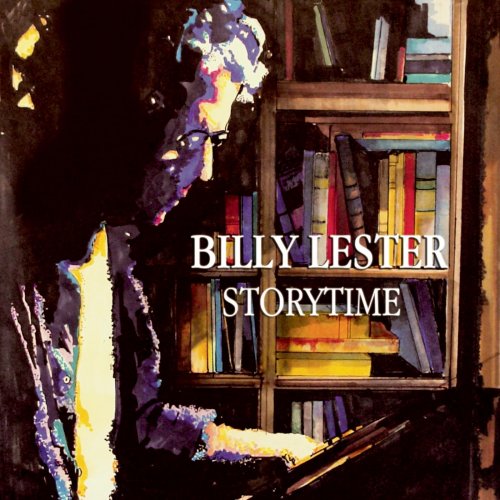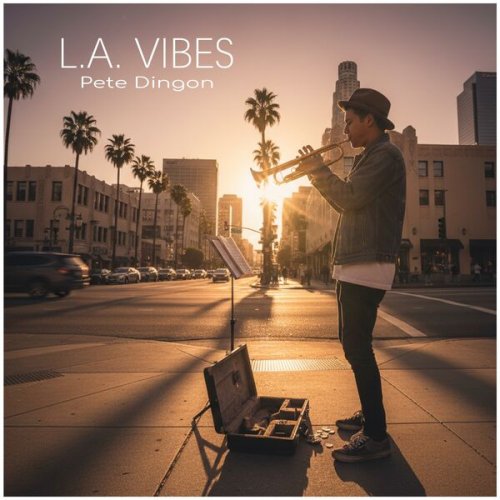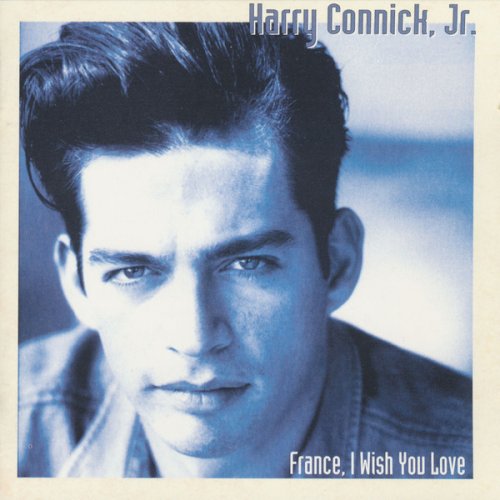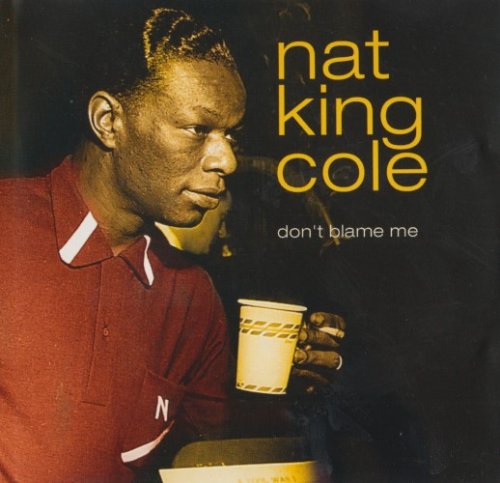VA - From Swing to Bebop: Jazz in History III (1999)
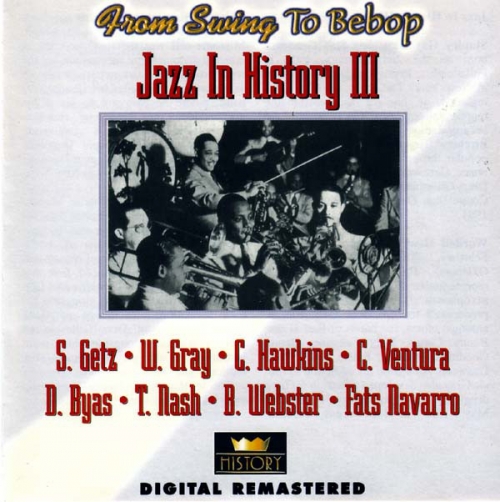
Artist: VA
Title: From Swing to Bebop: Jazz in History III
Year Of Release: 1999
Label: History
Genre: Jazz, Swing, Bop
Quality: Flac (tracks, .cue, log)
Total Time: 01:25:32
Total Size: 308 Mb (scans)
WebSite: Album Preview
Title: From Swing to Bebop: Jazz in History III
Year Of Release: 1999
Label: History
Genre: Jazz, Swing, Bop
Quality: Flac (tracks, .cue, log)
Total Time: 01:25:32
Total Size: 308 Mb (scans)
WebSite: Album Preview
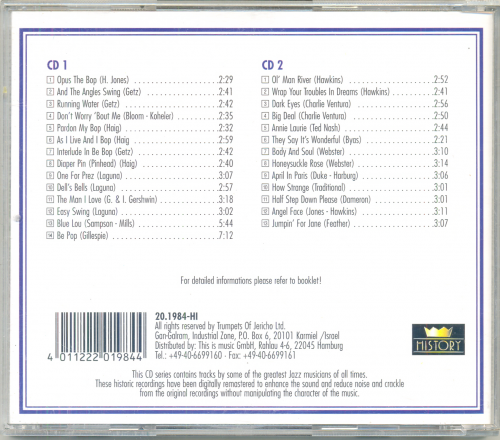
Tracklist:
CD1
1. S. Getz - Opus The Bop (H. Jones) 2:29
2. S. Getz - And The Angles Swing (Getz) 2:41
3. S. Getz - Running Water (Getz) 2:42
4. S. Getz - Don't Worry 'Bout Me (Bloom, Koheler) 2:35
5. S. Getz - Pardon My Bop (Haig) 2:32
6. S. Getz - As I Live And I Bop (Haig) 2:59
7. S. Getz - Interlude In Be Bop (Getz) 2:42
8. S. Getz - Diaper Pin (Pinhead) (Haig) 2:40
9. W. Gray - One For Prez (Laguna) 3:07
10. W. Gray - Dell's Bells (Laguna) 2:57
11. W. Gray - The Man I Love (G. & I. Gershwin) 3:18
12. W. Gray - Easy Swing (Laguna) 3:02
13. W. Gray - Blue Lou (Sampson, Mills) 5:44
14. W. Gray - Be Pop (Gillespie) 7:12
CD2
1. C. Hawkins - Ol' Man River (Hawkins) 2:52
2. C. Hawkins - Wrap Your Troubles In Dreams (Hawkins) 2:41
3. C. Ventura - Dark Eyes (Charlie Ventura) 2:56
4. C. Ventura - Big Deal (Charlie Ventura) 2:50
5. T. Nash - Annie Laurie (Ted Nash) 2:44
6. D. Byas - They Say It's Wonderful (Byas) 2:21
7. B. Webster - Body And Soul (Webster) 3:10
8. B. Webster - Honeysuckle Rose (Webster) 3:14
9. Fats Navarro - April In Paris (Harburg, Duke) 3:06
10. Fats Navarro - How Strange (Traditional) 3:01
11. Fats Navarro - Half Step Down Please (Dameron) 3:01
12. Fats Navarro - Angel Face (Hawkins, Jones) 3:11
13. Fats Navarro - Jumpin' For Jane (Feather) 3:07
The 1st CD is a collection of Hampton recordings, from several dates (one, two or three tracks per session)held between April 1937 and July 1940, and in the context of diversified bands or fronting his own, on the later tracks; an interesting one as it divulges Hampton’s multi-instrumentalist and showman abilities- namely on the 1st half of the CD : on certain tracks he doubles on piano as on “I Know That You Know” or “12th Street Rag”, on many he sings with his soft and soothing but expressive tone, still on others the focus is on his primary instrument, and his exuberant style of drumming, as on his originals “Drum Stomp” or “House of Morgan”.
But as expected it’s his vibraphonist style and distinctive sonority – which grow richer in tone and subtler in technique as time passes by and may be evaluated listening him successively in “Ring Dem Bells”(1938), “Memories of You”(1939) and “Blue Because of you”(1940) -, that distinguishes this material from a multitude of composers including Ellington, Morton ,Ory or his already mentioned originals; sometimes electrifying (“I’ve Found a New Baby”) others mourning (“Singin’the Blues”) or simply entertaining as “Doug-Rey-Mi” but always on the verge of perfection. Many other players stand out, namely Johnny Hodges and Cootie Williams up until mid-39, Hawkins and Webster or Goodman and Christian who contribute to impel “The Sheik of Araby” and who appear after 39; pianist Clyde Hart and drummer Cozy Cole are however, the most extensively featured accompaniers.
The Red Norvo material comes from dates in between September 1934 and September 1938 (except for the above mentioned pair of 1947 tracks with Giuffre); his xylophone played with his virtuoso style and a technique oriented for xylophones and marimbas –that coupled with his sound firmly distinguished him from Hampton- is heard along side clarinetists Artie Shaw or Donald McCook, trumpeters Bunny Berigan or Stew Pletcher, trombonist Jack Jenney, sax players Charlie Barnet or Chu Berry, piano players Teddy Wilson or Howard Smith, drummers Billy Gussak, Gene Krupa or Bob White; the material includes Gershwin perennials as “I Got Rhythm”, thrilling instrumentals as “I’ll Follow You”, animated dance-band numbers, Norvo originals such as “Blues in E-flat”, and many popular songs of the era including several ballads; a vocalist with a quasi-comic-like genre, Mae Questal sings “The music goes round and round” (an historical curiosity really), Red himself sings lead on tracks such as “Polly Wolly Doodle” or “”The Wedding of Jack and Jill”, but it’s his wife Mildred Bailey who from 38 onwards with her angelic tone and backed by a reinvigorated 12tet with a more updated sonority, stands out on the vocalized themes.
But as expected it’s his vibraphonist style and distinctive sonority – which grow richer in tone and subtler in technique as time passes by and may be evaluated listening him successively in “Ring Dem Bells”(1938), “Memories of You”(1939) and “Blue Because of you”(1940) -, that distinguishes this material from a multitude of composers including Ellington, Morton ,Ory or his already mentioned originals; sometimes electrifying (“I’ve Found a New Baby”) others mourning (“Singin’the Blues”) or simply entertaining as “Doug-Rey-Mi” but always on the verge of perfection. Many other players stand out, namely Johnny Hodges and Cootie Williams up until mid-39, Hawkins and Webster or Goodman and Christian who contribute to impel “The Sheik of Araby” and who appear after 39; pianist Clyde Hart and drummer Cozy Cole are however, the most extensively featured accompaniers.
The Red Norvo material comes from dates in between September 1934 and September 1938 (except for the above mentioned pair of 1947 tracks with Giuffre); his xylophone played with his virtuoso style and a technique oriented for xylophones and marimbas –that coupled with his sound firmly distinguished him from Hampton- is heard along side clarinetists Artie Shaw or Donald McCook, trumpeters Bunny Berigan or Stew Pletcher, trombonist Jack Jenney, sax players Charlie Barnet or Chu Berry, piano players Teddy Wilson or Howard Smith, drummers Billy Gussak, Gene Krupa or Bob White; the material includes Gershwin perennials as “I Got Rhythm”, thrilling instrumentals as “I’ll Follow You”, animated dance-band numbers, Norvo originals such as “Blues in E-flat”, and many popular songs of the era including several ballads; a vocalist with a quasi-comic-like genre, Mae Questal sings “The music goes round and round” (an historical curiosity really), Red himself sings lead on tracks such as “Polly Wolly Doodle” or “”The Wedding of Jack and Jill”, but it’s his wife Mildred Bailey who from 38 onwards with her angelic tone and backed by a reinvigorated 12tet with a more updated sonority, stands out on the vocalized themes.


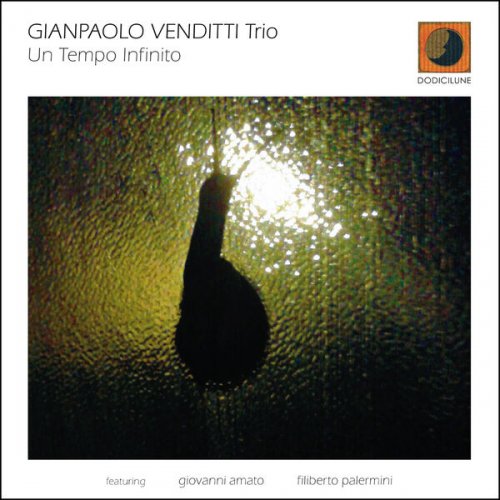
![Wilbur "Bad" Bascomb, Bernard "Pretty" Purdie - The Electric Bass Sessions - Pretty Bad Breaks Volume 1 (1992) [Hi-Res] Wilbur "Bad" Bascomb, Bernard "Pretty" Purdie - The Electric Bass Sessions - Pretty Bad Breaks Volume 1 (1992) [Hi-Res]](https://img.israbox.com/img/2026-01/20/gv9t6qrqztbpkdy0d6lpdor6s.jpg)

